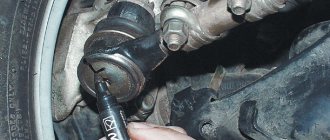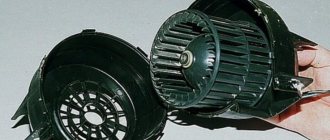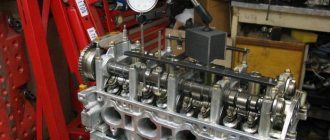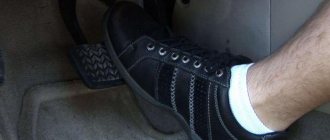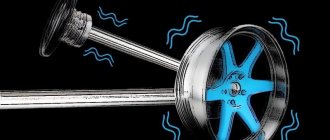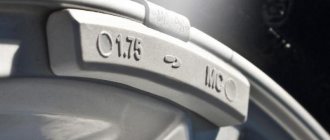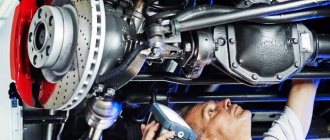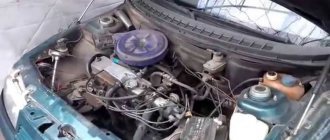It's no secret that you need to take care of your car. When internal systems do not work properly, an unpleasant phenomenon can occur in which the steering wheel begins to vibrate during the operation of the braking system. Such circumstances greatly interfere with movement. The sensation of beating occurs, as a rule, due to impacts or deformation of the discs. One way or another, the damage needs to be fixed.
Find out the cost of diagnosing the brake system online in 3 minutes Don't waste your time - use the Uremont search and get offers from nearby services with specific prices!
Get prices
Causes of steering wheel beating when braking
The reasons may be different:
- damaged bracket for motor support elements;
- worn CV joint;
- broken shape of wheel rims, etc.
However, each of the listed malfunctions can cause the steering wheel to shake not only when the speed is reduced. The most common cause of vibration when braking is either bent discs or defects in disc brakes.
You shouldn’t put off solving the problem; it’s better to react quickly and take the car to a service center for diagnostics. Professionals will determine the true cause of mild vibration when braking (and more severe vibration) using specialized equipment. You can check why the steering wheel shakes yourself, but without experience, a simple inspection will not help you understand the condition of the car. Often drivers decide to solve the problem on their own and start doing things that have nothing to do with the cause. In order not to waste your nerves and time, give your car for repair to specialists at car repair shops, where they will quickly understand why there is vibration when braking.
Why does the steering wheel shake at speed?
Why does the steering wheel shake at a speed of 100 km/h? The reason for the steering wheel beating in this case is not as clear as in the case of braking. The problem is typical for both the domestic automobile industry and foreign-made cars. The following reasons for the steering wheel beating at high speed are identified:
- wheel imbalance (it’s worth checking the front wheels);
- disc deformation (disc deformation is caused by physical impact on it during an accident or is associated with the current properties of the road surface);
- the appearance of a “hernia” due to damage to the tire (even a slight deviation in the wheel geometry leads to vibration);
- dirt adhesion and ice formation (adhered lumps of dirt become ballast, which creates additional load on the axles);
- incorrect wheel alignment or worn hub cap;
- pressure difference in the wheels (difference in resistance creates vibration);
- malfunction of the front suspension (wear of shock absorbers or silent block);
- faulty CV joint.
If the steering wheel shakes when driving, there is no need to hesitate in solving the problem. In order to get rid of an unpleasant knocking noise, you need to conduct independent diagnostics and deal with the defect. How to do it?
- The rims and wheels should be cleaned of dirt and the pressure in the front tires checked;
- It is worth checking the wheels, discs and brake pads for integrity (presence of a hernia, worn out disc, worn out brake pads, etc.);
- If after completing the first two steps no problems are identified, then you should try swapping the wheels.
Vibration during braking and its causes
A common cause of vibration when braking is bent brake discs. The rotor itself begins to move at the same moment when the wheel does so. When a car reduces speed mechanically, the rotor and pad structures are clamped. If the device malfunctions, traveling by car becomes dangerous. It turns out that the disks need to be replaced in time.
Why is the load on the steering wheel if the components are out of shape? The fact is that the part itself is made of metal and can have different widths. As soon as the foot presses the pedal, the mechanics of the pads press on the disc on both sides. The entire structure immediately becomes subject to heavy load, and the temperature of the disk increases. Temperature changes change the metal, gradually deforming its appearance. Wavy irregularities begin to appear. This is what causes vibration in the steering wheel, caliper or the entire car. Thus, having figured out the first reason, you need to remove the wheel and find out the condition of the brake disc. A bluish tint is the main sign of deformation. If you lift the vehicle with a jack, you can see how the structure moves in the free rotation of the wheel. Another way is to brake using the handbrake: if the steering wheel shakes, the problem is obvious.
There is no point in trying to level the surface; it will be much easier to replace it. This is a rather expensive procedure; it will cost no less than 10 thousand rubles. An economical option that the service will offer is boring the disk, then the formed waves are ground down until the surface of the disk becomes smooth.
Steering wheel shakes at low speed
If the steering wheel hits hard at low speed, then the following reasons for this problem can be identified:
- worn tires (it is better to buy new tires if bumps, bumps or hernias are clearly visible);
- internal tire wear (solved by removing a handful of worn rubber from the tire);
- damage to the disk, including severe damage (a bent edge or even a “figure eight” on the disk);
- poor balancing.
Be sure to check the Ackermann angle and caster angle, the incorrect installation of which can affect the service life of car parts. Any violation of the wheel geometry leads to vibrations; if these vibrations are not noticeable at high speed, it means that the problem has not yet developed into a disaster.
Strong vibration when braking
The discs and other elements were replaced, but the vibration did not go away. What's the matter? To understand why vibration occurs when braking, you need to put everything in order. If the chassis has already been repaired, but the steering wheel continues to vibrate, most likely the reasons are hidden right here. When replacing a hub, bearing or brake rotors, the obvious choice may be a poor quality part or improperly tightened mounting parts. Improperly carried out repairs are one of the factors causing strong vibration during braking. With this in mind, it is worth looking for a reputable mechanic with good reviews. When vibration when braking at speed appears after replacing any of the three named spare parts, all complaints should be sent to the technician who performed the work.
The steering wheel beats when the speed decreases:
- due to problems with the rack, or the reason is wear of the ball-type connection in the running system;
- from dysfunction of shock absorbers;
- after the shock absorber elements wear out, this means that they may soon break;
- if there is a strong and sharp impact on the disk;
- when the steering tips are faulty.
A crack in the brake rotor can also cause vibration after braking. Impacts and other external influences cause cracks. This failure is a common type of damage among worn brakes. Worn brakes themselves do not cause steering wheel vibration, since this depends solely on the specific disc.
How to detect wear on brake discs?
Before repairing, it is necessary to diagnose the breakdown. Is it just the steering wheel that vibrates? The likely cause is wear of the front brake discs or the system as a whole. Has the brake pedal also changed its behavior? Pay attention to the rear braking system.
The handbrake can be used to determine the malfunction. If the vibration stops when using it, then you should look for a problem in the front brake system. Is there any beat left? Examine the technical condition of the rear brake discs and the system as a whole. The procedure allows you to determine the location of deformed parts.
Next, you should test the wheels or study the appearance of the brake discs. Raise the car on a jack and remove it from gear. If the rear axle is suspected, then the handbrake must be lowered. Spin the wheel. Is the rotation uneven and changing intensity in the same place? The problem has been identified. If the test result is negative, move on to the next wheel.
The appearance of the brake disc says a lot about its technical condition. Noticed cracks, unevenness or chips? Replacement or grooving is required, depending on the situation. The presence of a bluish tint on the surface is a sign of overheating.
When inspecting, pay attention to the brake calipers. It's unlikely, but they can also cause vibrations in the steering wheel.
Why is there vibration when braking?
Only understanding the type of breakdown can determine your further actions. To figure it out, we recommend:
- First, it is enough to check the tires for the formation of a hernia. Next, you need to check the wheel balancing on the stand. We check newly installed disk parts for defects. If it is found, only replacement will solve the problem.
- Next, the brake discs must be checked for wear. They could lose their shine or simply wear out. In this case, check the condition of the rubber bands on the caliper guides. If they are torn, a characteristic grinding sound may occur when braking. We also remember the most common problem - changing the shape of the brake discs.
- The bearing and hub should also not be deformed; we check them. Next, we look at the steering rod: there should be no gaps between the tips. To inspect the system, you will need to place the machine on a lift. Pulling the rod from side to side, we check for the presence of play. If there is one, we replace the parts.
- We check the ball joints while the car is jacked up. When the wheel is able to spin freely, try to shake it a little. Strong vibration of the wheel indicates that the ball joint is worn out. Replacement required.
- As a result, we check how the wheels are secured and the fastening elements are installed. The steering wheel will vibrate if the wheels are not secured correctly. This is easy enough to figure out.
Steering
Here, the steering wheel may hit the steering wheel when braking due to worn or misadjusted steering elements.
At the same time, many believe that if there is play in the steering, the beating will be constant while driving, but we are considering the occurrence of impacts only when braking.
But this is not entirely true, and in order to understand how wear of the steering mechanism can affect the processes occurring when a car is braking, we should consider the theory a little.
The wheel always moves along the path of least resistance, and the higher the speed, the more difficult it is for it to change its trajectory.
When braking, the wheel slows down significantly, which can affect the trajectory of the latter.
If the steering mechanism is in good condition, it will keep the wheel in the desired path.
But if, as a result of wear, there is even a slight gap (1 mm), for example, between the rack and gear of a mechanism, then it will provide a lateral play of 3-4 mm on the wheel.
That is, the wheel will no longer be rigidly held, and it will be able to voluntarily change its trajectory within the range of available play, and this change is of a vibrational nature.
And from the wheel this vibration is transmitted to the mechanism and then to the steering wheel.
Therefore, if there is a beating in the steering wheel when braking, you should definitely check for play in:
- Rack and pinion pair;
- Steering tips;
- Cardan transmission of the steering column.
Using the HYUNDAI HD 72 as an example, it looks like this.
You should also definitely check the condition of the tie rods being attached to the rack.
Know-how
Carrying out all of the above yourself means losing a colossal amount of effort and time. Without experience in this area, you should seek help from professionals who will help you save money and quickly troubleshoot problems, after which the vibration will stop. In addition, you will have to take responsibility for possible problems due to improper self-repair.
We offer the website Uremont.com. Here users find the highest quality car repair companies. The resource constantly updates information for a more accurate understanding of the reputation of services. The aggregator will allow you to order a service directly on the website and not waste time in line.
Chassis components
If, after checking, the vibration on the steering wheel during braking does not go away, you should move on to other potential suspects. These include the chassis of the car.
When it is determined that the causes of vibrations come from the front end, but no problems have been identified in the brake assembly, examine the condition of the chassis. Most often, if the steering wheel shakes when you press the brakes in a car, the culprits are the tie rods and tie rod ends.
In the absence of the necessary experience, it is quite difficult to diagnose such a malfunction in the form of deformation of these elements. Take a closer look, perhaps you will see uncharacteristic changes in geometry, some bends. Sometimes it is necessary to carry out diagnostics of the entire chassis.
The elements of the chassis also include wheels. If you notice a hernia or deformation in the tires, and at the same time the steering wheel hits hard directly when braking, you should simply change the tires. In some cases, damage is observed on the inside. Here you will have to disassemble and examine the condition of the tires from the inside.
How to avoid car brakes from squealing
If the brake pedal begins to vibrate when pressed, then this problem will not go away on its own. It is necessary to diagnose the machine as soon as possible and eliminate the malfunction. To avoid such troubles in the future, you need to follow these recommendations:
- Monitor the brake fluid level in the reservoir;
- Regularly check the brake system for leaks;
- Change the pads on time, without waiting for their maximum wear.
The braking system is nothing to joke about, and at the first symptoms of its malfunction, the problem should be eliminated.
(422 votes, average: 4.56 out of 5)
What is the danger of steering vibration
Most often, such a malfunction does not require quick repair. If you don't brake too hard, you can drive the car for many years. However, it should be remembered that a high load is created on the chassis. Without carrying out repairs, it may turn out that you will have to spend a significant amount in subsequent repairs.
An important point is the pleasure of driving a car. The vibration of the steering wheel does not allow you to fully enjoy the ride. The best solution in this case is to carry out repairs if you have the money. This malfunction does not require urgent repair, but the repair should not be constantly rescheduled for another time. This reduces your own comfort and increases the cost of future repairs.


